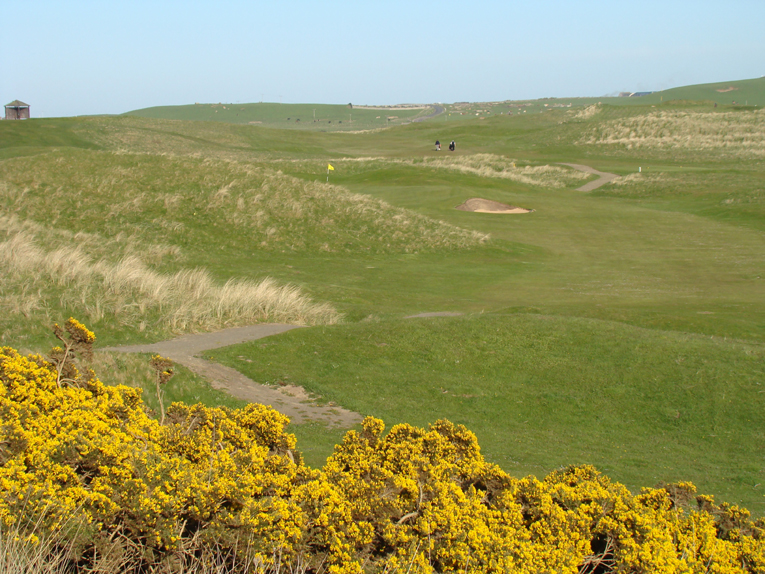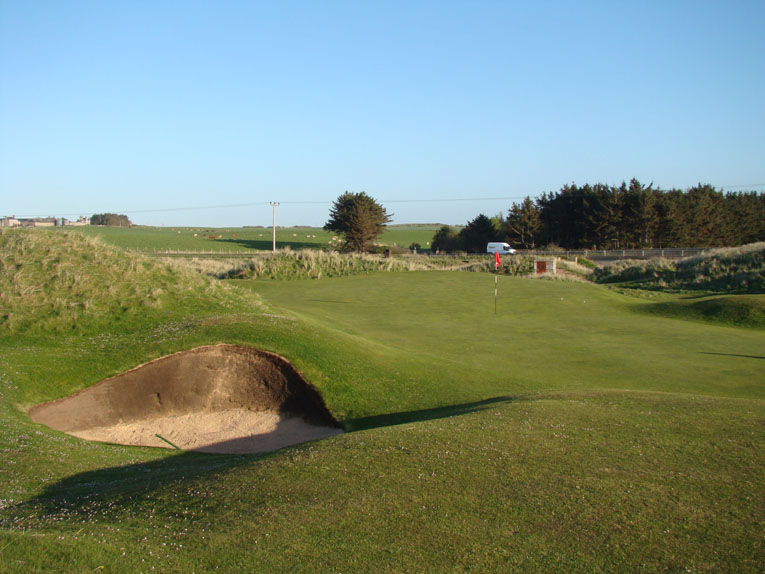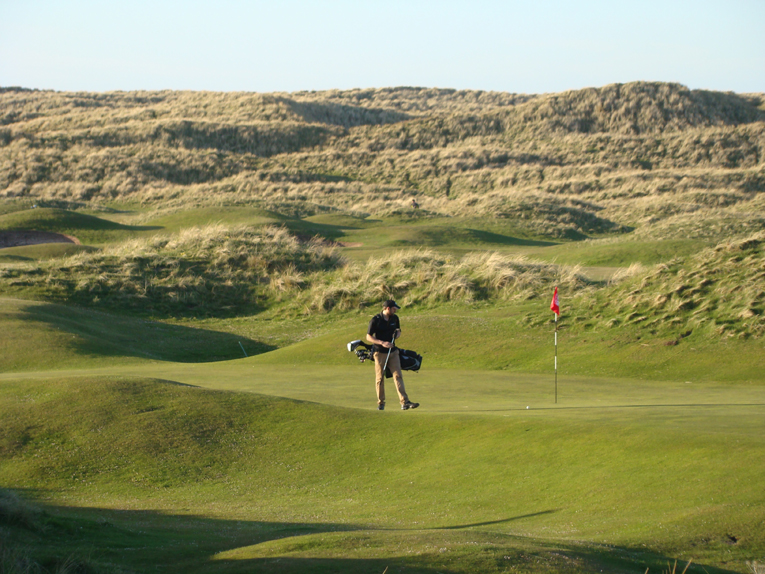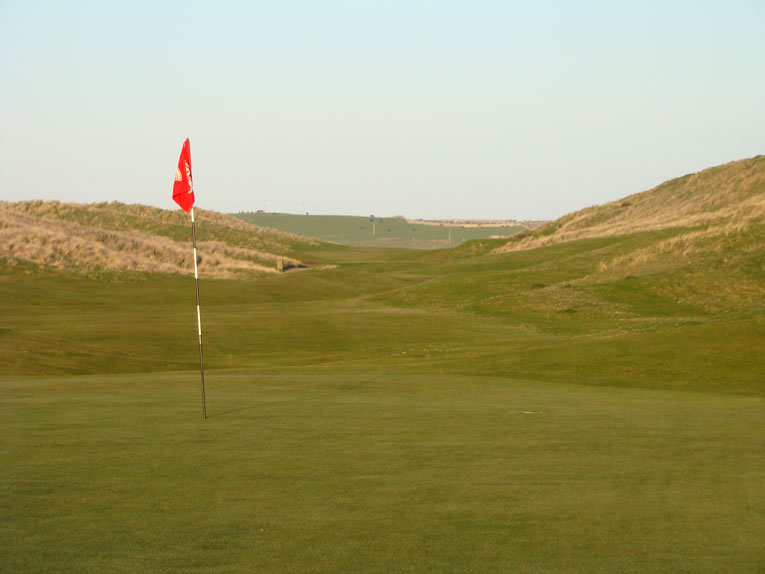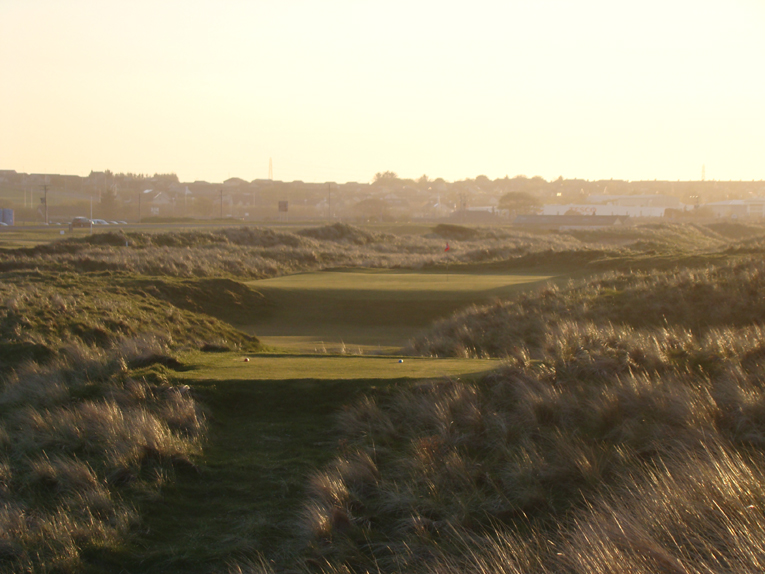Fraserburgh Golf Club
Aberdeenshire, Scotland, United Kingdom
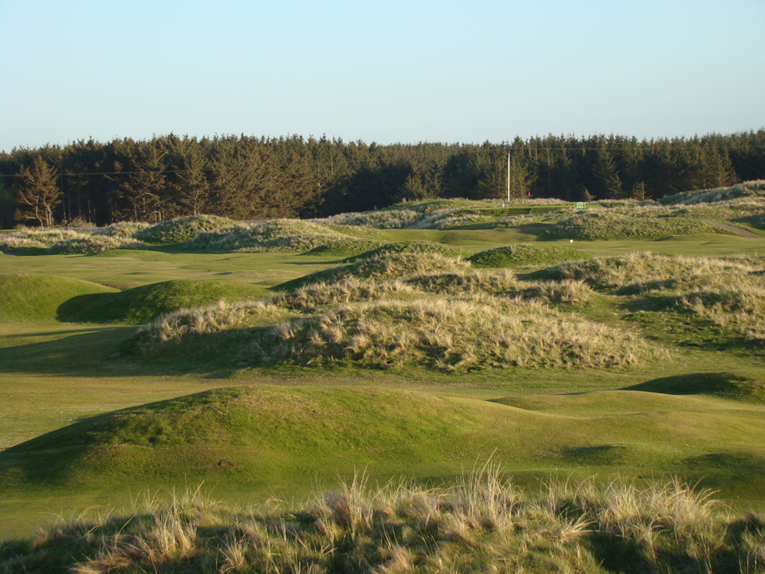
Yum! Fraserburgh’s scintillating landscape gets the heart racing every bit as much as that of more famous links.
Is Fraserburgh a great minor links or is it a minor great links?
The answer depends largely upon your perspective of the game and what you hope to gain from it. A bomber that carries the ball 290 yards might find that the 6,310 yard, par 70 course is unable to test every club in the bag unless the wind is brisk. Conversely, the majority of golf enthusiasts that play happily with modest expectations for a good score will find the charms of Fraserburgh to be as captivating as any course in Scotland.
It has everything required of a cult classic: an enchanted setting, crumpled land galore, sweeping long vistas, and a collection of distinctive and sometimes unusual holes. Throw in a most welcoming club atmosphere and it’s easy to see why the visitor with a ten handicap might just as soon enjoy a game here as at more famous links.
The club is justly proud of its heritage. Founded in 1777, it is among the oldest in the world. Indeed, Fraserburgh claims to be the oldest operating under its original name. However, its golf wasn’t always played here and today’s course didn’t take shape until 1920. The club gives primary credit to James Braid for the course we enjoy today.
Set mostly in the dunes near where the North Sea and Moray Firth meet on Scotland’s northeast side, Fraserburgh enjoys a romantic, primordial setting. Yet, golfers who venture here might initially doubt the wisdom of their actions. As seen from the clubhouse windows, the first and eighteenth holes parallel each other and are as flat as flat can be. Hardly the epic stuff of links golf! Doubts creep in – have I made a mistake in coming? The answer will soon be obvious and is emphatically NO. The second hole climbs Corbie Hill and from the third tee (the high point on the course) all is revealed. The town of Fraserburgh and the fishing village of Inverallochy lie to the west and virtually all of the holes lie north and east of this vantage point.
The course builds throughout the round. The first five play toward and then over Corbie Hill and feature soil that is more clay than sand. The next seven play mostly up and back from each other and leave the golfer at a far point from the clubhouse. The final stretch save for the anti-climatic Home hole play through the best, mightiest dunes.
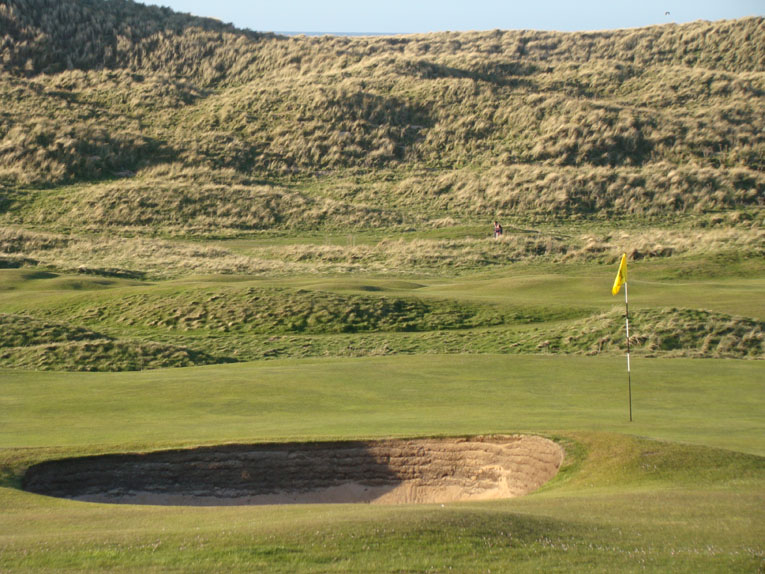
This view across the course shows the human scale of the dunes that are so admirably put to use throughout much of the course. The mighty shoreline dune in the distance stays on the golfer’s right as he heads home from fourteen.
James Braid was a champion golfer of the highest order imaginable, a winner of five Open Championships. Along with Harry Vardon and J.H. Taylor, he formed a triumvirate that was accurately dubbed ‘great.’ As his playing days waned, he became an active architect but his work never quite achieved the top tier reserved for titans like Park, Colt, MacKenzie, Fowler and Alison. His most famous course is surely the King’s Course at Gleneagles set in the magical Perthshire countryside; Enodoc, Brora and Deal mark other design high points. Similar to them, the golfer leaves Fraserburgh with a feeling that he has just played holes unlike any in the world.
According to Gordon Moir, who joined the Fraserburgh greens staff in 1976 and is now the Director of Greenkeeping for the St. Andrews Links Trust, there were two major periods of change to Braid’s work. The first came in the 1950s when the fifteenth, sixteenth and seventeenth holes were created in lieu of holes that played back and over Corbie Hill. Moir is quick to note that several of Braid’s replaced holes were extremely good. However, the three new holes through the tall dunes have the marked advantage of being situated on ideal sandy land close to the sea. The second major series of alterations came in the mid-1970s when two sets of parallel holes were created, the eighth/ninth and eleventh/twelfth. Gone were several flat, unremarkable holes on the clubhouse side of the road.
No known or name architect is credited for overseeing either set of changes. However, given how well the holes are knit together and how well the course flows, one can only infer that the work was done by someone intimately familiar with the course. No doubt about it: people with a strong feel for the land did the work. No architect rushed in, drew some squiggly lines and left.
These improvements constitute a huge gain for the course but by the time of their completion Bernard Darwin and similar scribes were no more and the course has never been properly chronicled. Did writers like Herbert Warren Wind and Pat Ward-Thomas who existed in the mid-1970s and reported golf in a meaningful, compelling manner ever visit this little seaside town? Maybe not. In any event, at least for this author, Fraserburgh is a course that evolved into a real gem over five decades and never received its proper due in print. Pictures don’t lie and after looking at the holes below, see if you agree.
Holes to Note
Second hole, 390 yards, Braid’s Bellow; The first hole measures 435 yards and the steeply uphill second plays virtually the same distance. So much for a gentle handshake! Huge eight to twelve foot mounds dot the landscape and break up the ascent as well as the flow of water over the sloping clay land. These mounds are quite a clever design ploy and have a greater impact than bunkers might. One thing that can be said about Braid is that his work resists being readily stereotyped unlike some other designers. His courses reflect their surrounds and the more intoxicating, like Fraserburgh, the more potent the outcome.

What a view looking back across the second green out toward Fraserburgh and Inverallochy! One of the hole’s big fairway mounds is prominent left of the green.
Fourth hole, 330 yards, The Plateau; The third and fourth are a pair of short 330 yard par fours that play in opposite directions. The third features stunning views from atop Corbie Hill before dropping to a green with a wonderfully wicked false front. Balls that land as far as seven paces onto the green retreat as much as thirty yards. The fourth heads in the opposite direction and plays notably different. Braid benched the green into the side of Corbie Hill. Hitting this plateau green – even with just a wedge – is one of the most satisfying shots on the course. To miss is to court a high score. Play for the middle of the green and be satisfied with a fifteen to twenty foot birdie putt.

Unusual for a hole of its length, the fourth can be a card wrecker. Shots short can leave this difficult recovery from the course’s deepest greenside bunker. Though sparsely bunkered, Fraserburgh’s thirty-nine bunkers all count for something.
Fifth hole, 185 yards, The Hump; From lower on the back shoulder of Corbie Hill, the golfer hits over a twenty foot hump/dune that partially obscures the putting surface. The busy main thoroughfare beside the hole can jangle frayed nerves.
Seventh hole, 165 yards, The Well; One of the prettiest views on the course is had from the elevated seventh tee with sprawling dunes behind the green as far as the eye can see. The vast landscape makes the already small target look even smaller. The right bunker eats into the putting surface, which sharply tilts from back right to front left.
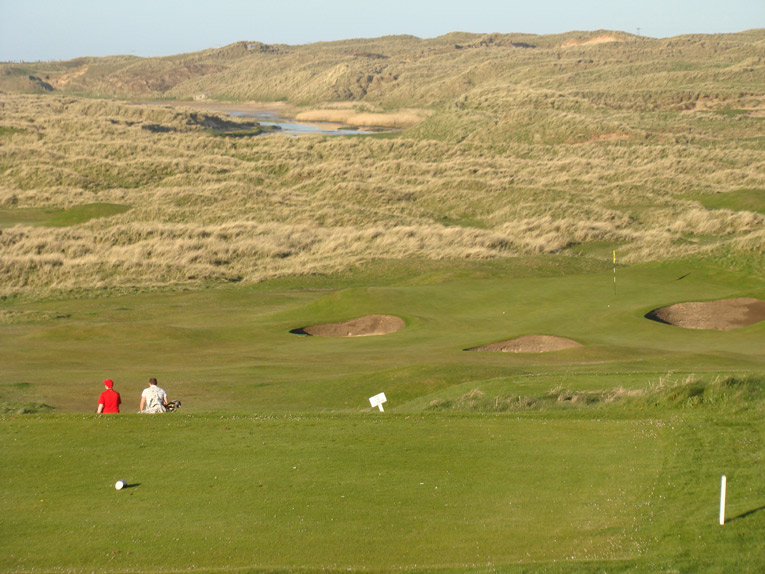
The tee ball near this back right hole location is a shot of extreme quality and it leaves the golfer with a makeable uphill chance for birdie.

A miss right of the green gives little hope of recovery given the green’s right to left slope. And yet, a recovery from the left as seen above is not headache free either courtesy of a dominant knob and steep bank.
Ninth hole, 460 yards, Lang Whang; The name says it all. This is a beast that is made special by the consummately humpy-bumpy landscape. It may not appear as dramatic as some of the other holes but is full of good golf quality. Though it was added more than fifty years after Braid’s course opened for play, this natural hole fits in well and its muscle compliments the older, quirkier short two shotters.
Fraserburgh Golf Club
Aberdeenshire, Scotland, United Kingdom
Tenth hole, 330 yards, Solitude; One of the cutest short two shotters the author has seen. The tee ball is aimed into a sea of dunes but the fairway is quite wide in the hitting area and a level lie can readily be obtained. The moment of truth comes with the pitch over a low dune to a flag that is visible to a well-positioned drive in the left center of the fairway. The long narrow green is brilliantly elusive, especially as it generally plays crosswind.
Twelfth hole, 390 yards, The Castle; Part of the charm of links golf is you never know what Mother Nature will serve up. Well removed from the water, this hole plays along a main feeder road into town. That’s two strikes against it and yet, Mother Nature provided – almost incongruently – some of the biggest dunes on the property. A well-struck tee ball that finds the twisting fairway nestled between the dunes makes for one of the most memorable drives of the round.
Thirteenth hole, 345 yards, The Hillocks; Two bunkers were cut into a pair of hillocks precisely where the golfer would like to land his tee ball. What to do? The wind and state of one’s game will determine whether you attempt the 230 yard carry or exercise prudence and lay-up.
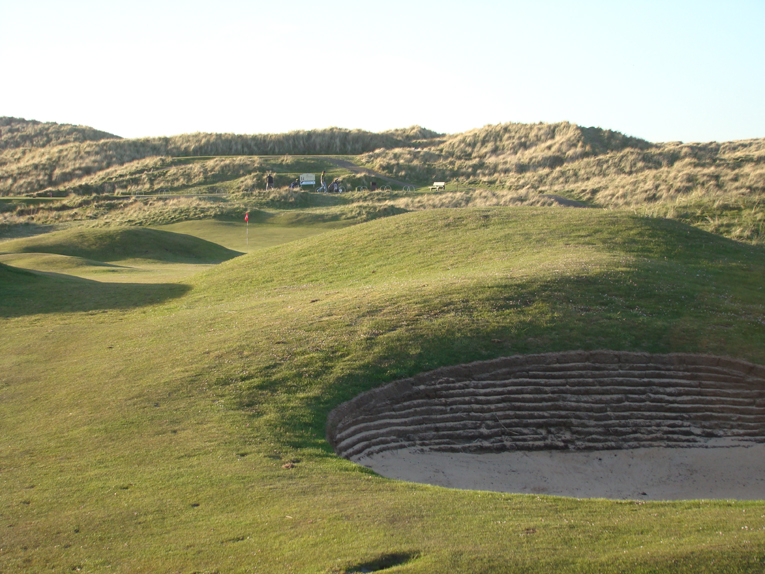
A lay-up short of this and its sister bunker to the left is oft times the intelligent play, especially since the golfer has yet to confront this wind direction. The thirteenth is the only hole that plays in a northerly direction.
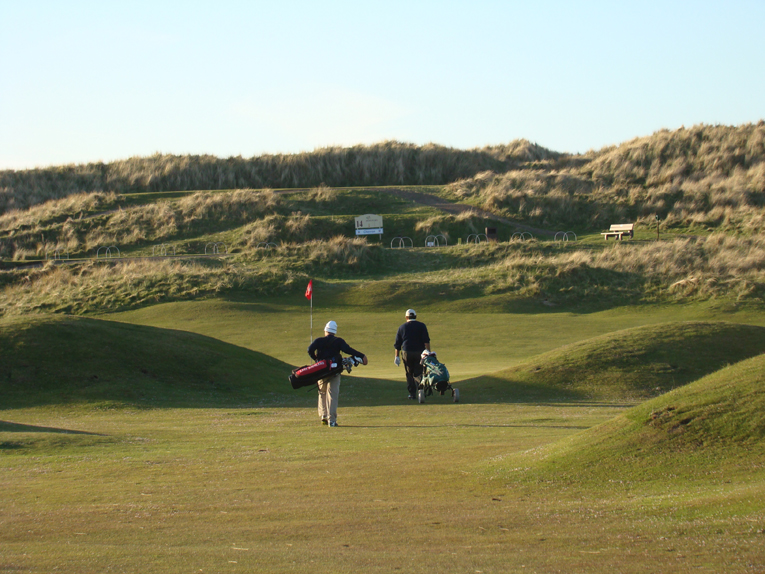
Note the back edge of the green relative to the golfer’s height. Yes, the green drops over five feet (!) from back to front. Give the greenkeeping crew full marks for their commitment to this green’s presentation as mowing grass short on such a pitch is no easy feat.
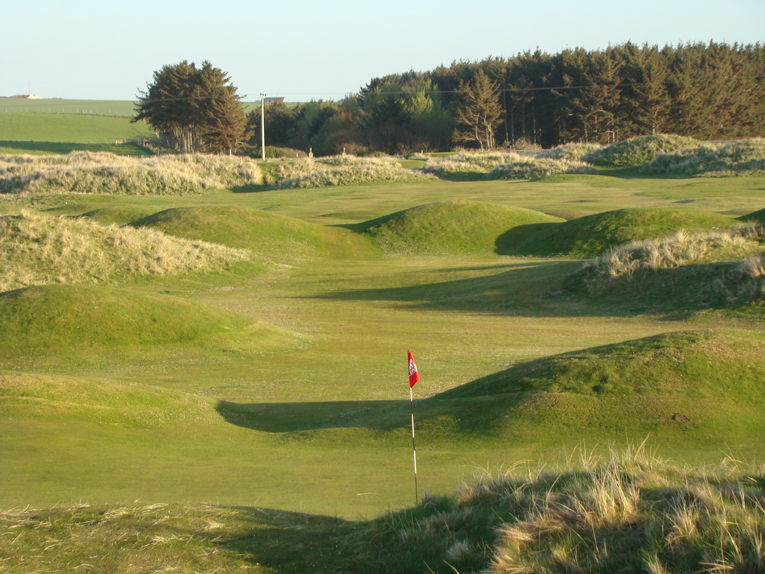
This view back down the thirteenth reveals how the two spectacle bunkers seal off the fairway from the tee.
Fourteenth hole, 200 yards, Homeward; While the thirteenth green features an enormous (!) backboard, and the third, seventh and the sixteenth putting surfaces have significant tilt as well, putting is otherwise a relatively straightforward affair to plateau greens at Fraserburgh. The fourteenth green, which has been in this location for less than thirty years, has the distinction of having the most interior contours of any on the course. Its cascading contours that Moir helped build in the mid 1980s create interesting back, mid and front levels. The prior green was some twenty-five yards to the right and had been built in the 1970s. Aptly named, this is the first of the final five holes that dart home.

The ridges in the green are evident in this zoomed in view from the tee of the green nestled low into the dunes.
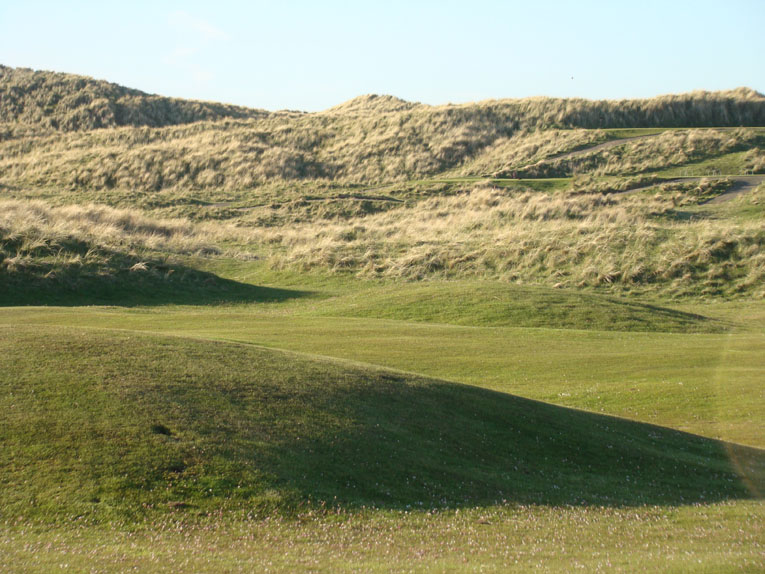
This view from across the course of the fourteenth tee areas benched into dune gives a sense of how much the fourteenth falls from tee to green. Controlling one’s tee ball from a perched tee is never easy in a windy environment like Scotland.
Fifteenth hole, 510 yards, The Bents; A drive left of center brings the green in view while a ridge line right of center makes the second shot blind. Though the shore is to the right, the hole rarely plays in a cross breeze. Generally the final five holes play either downwind or into the wind. Here, an opposing wind makes this a straightforward three shotter but downwind the hole becomes more vexing. Second shots that don’t find the green benched into the dune follow the short grass left of the green complex and are stymied by a clever back left bunker.
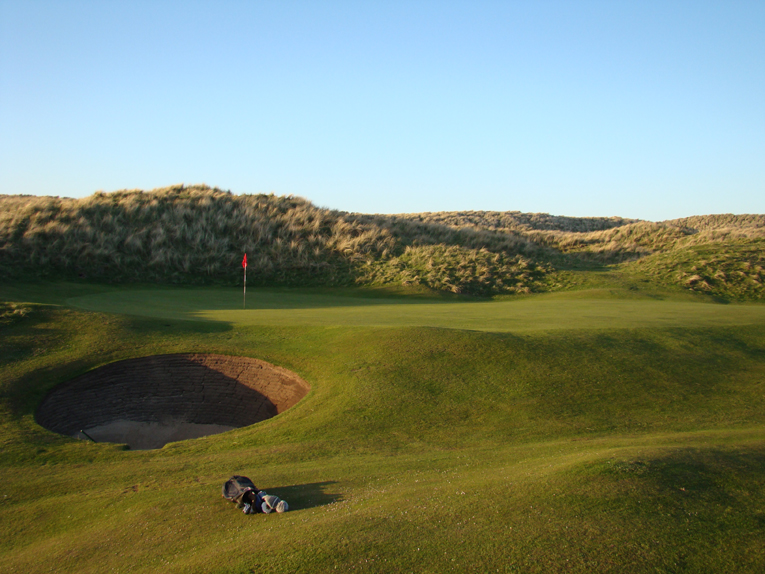
Missing the green left gets increasingly problematic. Better to stay short and chip up its length. This advice is true for much of the course. Keep the greens in front of you; missing to the sides or long will cause the brow to furrow.
Sixteenth hole, 380 yards, The Valley; With Corbie Hill high on the left and tall dunes along the Moray Firth to the right the name is apropos. On the one hand, the landforms are the biggest on the course. On the other, the bunkers compress the hitting area into one of the narrowest on the course. Squeezing one’s tee ball between the three fairway bunkers is key.
Seventeenth hole, 190 yards, Peninsula; The top of a dune was leveled and voila, a classic was born. The labor was minimal yet the result is timeless: hit the plateau green or else! Each of the four one shotters is memorable and each has its own admirers within the club. A minor quibble is that they all fall in the 165 to 200 yard range and they don’t box the compass. Nonetheless, 99% of quality courses around the world would gladly trade their set of one shot holes for the sterling collection found here.
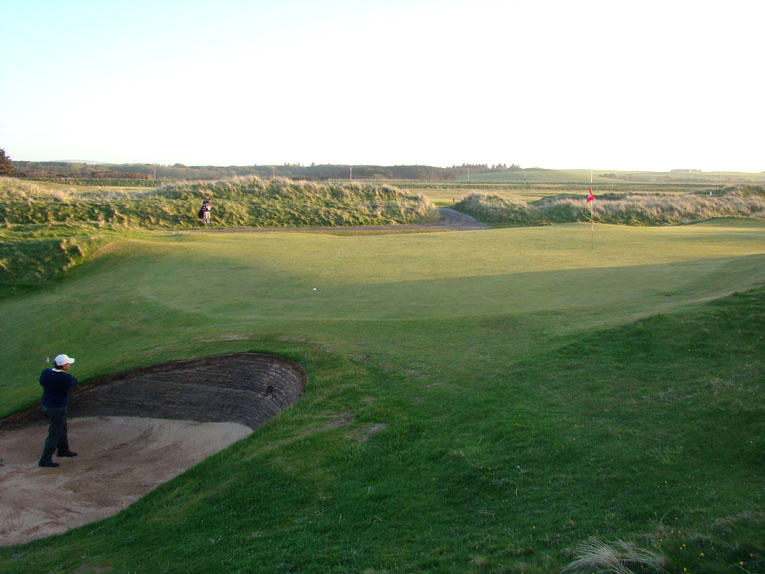
The solitary bunker and the tightly mown bank that leads onto the putting surface create problems for short tee balls. The green narrows toward the back so playing safely long isn’t an option.
There you have it. Braid provided the backbone for the course that exists today. Some of the best, most flavorful holes (e.g. the second, fourth, fifth, seventh, thirteenth) are his. Some others (e.g. the ninth, twelfth, fourteenth, and the fifteenth through seventeenth) were created later. Most importantly, the holes and the sequence of shots required by them are well balanced. The golfer happily bounces among holes built in the 1920s, 1950s and 1970s blissfully unaware of their evolution. Gordon Moir has seen the course for as long and in as many conditions as anyone and sums it up nicely when he notes, ‘I always thought the course was a fair but tough test in whatever conditions. You needed to be long on some holes, precise on others and shape the ball both ways. Getting on the wrong side often meant you couldn’t hold the green and therefore, although your short game had to be sharp you usually had the choice of playing a variety of shots to recover. The opportunity is there to score low but once you get on that bogey trail… .’
How nice to find a course that challenges but doesn’t humiliate you up in the process! Any but the mightiest golfer will be delighted to find himself in such an environment. Given the cast of holes, why this course isn’t better known far and wide is stupefying. Cruden Bay, a scant thirty minute drive away, was discovered in the 1990s. Perhaps Fraserburgh will be discovered in the next decade? It is most deserving of play and accolades will surely follow.
The End


